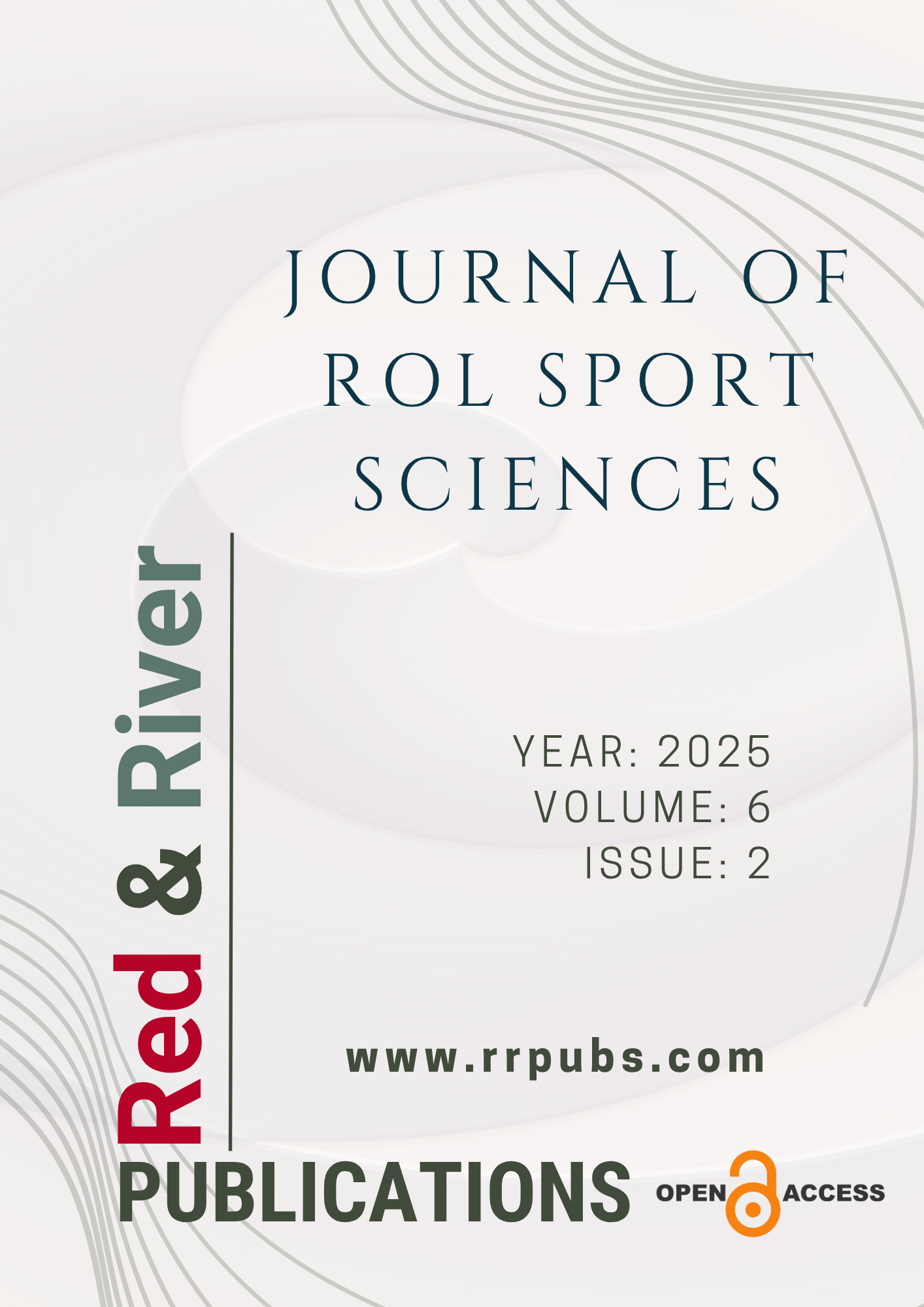Aerobic exercise and catecolamine: A bibliometric analysis
DOI:
https://doi.org/10.70736/jrolss.1718Keywords:
Aerobic exercise, bibliometric analysis, catecholamine, sport sciencesAbstract
This study performed a bibliometric analysis of scientific literature on aerobic exercise and catecholamines to map the evolving knowledge structure in this important field, which has implications for both physical health and neurochemical regulation. Using data from the Web of Science and Scopus databases, publications published between 2000 and 2024 were analyzed. VOSviewer software was employed to visualize co-authorship, keyword co-occurrence, and citation patterns. The analysis focuses on publication trends, disciplines, keyword networks, authors, institutions, countries, and journals. The findings revealed that the number of publications showed a significant increase after 2010, while the number of citations peaked in 2015, exceeding 700 in 2021, but started to decline after 2022. Sports Sciences (102 publications) and physiology (74 publications) were the most dominant disciplines, while Endocrinology and Metabolism and Neurosciences also made significant contributions. Keyword networks showed that ‘catecholamines’ and ‘exercise’ were central concepts, linked to themes such as cardiovascular responses and insulin sensitivity. McMorris, T. (850 citations) and Kindermann, W. (839 citations) lead among authors, the University of Chichester (981 citations) leads among institutions, and the USA (5263 citations) leads among countries. Journal analysis revealed that the Journal of Applied Physiology has 1738 citations. The discussion emphasized the interdisciplinary nature of the field and its academic impact while highlighting the lack of local contributions, such as in Turkey. These results suggest that aerobic exercise and catecholamines offer a rich research area for both basic science and clinical applications. Suggestions include expanding the scope of bibliometric analyses using new analytical methods, focusing on underrepresented disciplines, and mapping the local literature. By mapping the current state of literature, this study aims to guide future research in this field.
References
American College of Sports Medicine. (2018). ACSM’s guidelines for exercise testing and prescription (10th ed.). Wolters Kluwer.
Aria, M., & Cuccurullo, C. (2017). Bibliometrix: An R-tool for comprehensive science mapping analysis. Journal of Informetrics, 11(4), 959–975. https://doi.org/10.1016/j.joi.2017.08.007 DOI: https://doi.org/10.1016/j.joi.2017.08.007
Beaulieu, J.-M., & Gainetdinov, R. R. (2011). The physiology, signaling, and pharmacology of dopamine receptors. Pharmacological Reviews, 63(1), 182–217. https://doi.org/10.1124/pr.110.002642 DOI: https://doi.org/10.1124/pr.110.002642
Bornmann, L., & Daniel, H.-D. (2010). Citation concentration in bibliometric research: A study of the relationship between citing and cited publications. Journal of Informetrics, 4(3), 399–405. https://doi.org/10.1016/j.joi.2010.02.002 DOI: https://doi.org/10.1016/j.joi.2010.03.007
Chrousos, G. P. (2009). Stress and disorders of the stress system. Nature Reviews Endocrinology, 5(7), 374–381. https://doi.org/10.1038/nrendo.2009.106 DOI: https://doi.org/10.1038/nrendo.2009.106
Cryer, P. E. (2001). The catecholamines and their role in the pathophysiology of disease. Endocrinology and Metabolism Clinics of North America, 30(4), 781–799. https://doi.org/10.1016/S0889-8529(05)70214
Dunn, A. L., Trivedi, M. H., & O’Neal, H. A. (2001). Physical activity dose-response effects on outcomes of depression and anxiety. Medicine & Science in Sports & Exercise, 33(6), S587–S597. https://doi.org/10.1097/00005768-200106001-00027 DOI: https://doi.org/10.1097/00005768-200106001-00027
Eisenhofer, G., Kopin, I. J., & Goldstein, D. S. (2004). Catecholamine metabolism: A contemporary view with implications for physiology and medicine. Pharmacological Reviews, 56(3), 331–349. https://doi.org/10.1124/pr.56.3.1 DOI: https://doi.org/10.1124/pr.56.3.1
Garber, C. E., Blissmer, B., Deschenes, M. R., Franklin, B. A., Lamonte, M. J., Lee, I.-M., ... et al. (2011). Quantity and quality of exercise for developing and maintaining cardiorespiratory, musculoskeletal, and neuromotor fitness in apparently healthy adults. Medicine & Science in Sports & Exercise, 43(7), 1334–1359. https://doi.org/10.1249/MSS.0b013e318213fefb DOI: https://doi.org/10.1249/MSS.0b013e318213fefb
Garfield, E. (2006). The history and meaning of the journal impact factor. JAMA, 295(1), 90–93. https://doi.org/10.1001/jama.295.1.90 DOI: https://doi.org/10.1001/jama.295.1.90
Glänzel, W. (2001). National characteristics in international scientific co-authorship relations. Scientometrics, 51(1), 69–115. https://doi.org/10.1023/A:1010512628145 DOI: https://doi.org/10.1023/A:1010512628145
Goldstein, D. S. (2010). Catecholamines 101. Clinical Autonomic Research, 20(6), 331–352. https://doi.org/10.1007/s10286-010-0065-7 DOI: https://doi.org/10.1007/s10286-010-0065-7
Haskell, W. L., Lee, I.-M., Pate, R. R., Powell, K. E., Blair, S. N., Franklin, B. A., ... et al. (2007). Physical activity and public health: Updated recommendation for adults from the American College of Sports Medicine and the American Heart Association. Medicine & Science in Sports & Exercise, 39(8), 1423–1434. https://doi.org/10.1249/mss.0b013e3180616b27 DOI: https://doi.org/10.1249/mss.0b013e3180616b27
Kvetnansky, R., Sabban, E. L., & Palkovits, M. (2009). Catecholaminergic systems in stress: Structural and molecular genetic approaches. Physiological Reviews, 89(2), 535–606. https://doi.org/10.1152/physrev.00042.2006 DOI: https://doi.org/10.1152/physrev.00042.2006
Leydesdorff, L. (2009). How are new citation-based journal indicators adding to the bibliometric toolbox? Journal of the American Society for Information Science and Technology, 60(7), 1327–1336. https://doi.org/10.1002/asi.21024 DOI: https://doi.org/10.1002/asi.21024
Moed, H. F. (2005). Citation analysis in research evaluation. Springer. https://doi.org/10.1007/1-4020-3714-7 DOI: https://doi.org/10.1007/1-4020-3714-7
Mongeon, P., & Paul-Hus, A. (2016). The journal coverage of Web of Science and Scopus: A comparative analysis. Scientometrics, 106(1), 213–228. https://doi.org/10.1007/s11192-015-1765-5 DOI: https://doi.org/10.1007/s11192-015-1765-5
Nieman, D. C. (1994). Exercise, immunity, and infection. Journal of Sport and Health Science, 3(2), 77–84. https://doi.org/10.1016/S0765-1597(05)80006-6
Pritchard, A. (1969). Statistical bibliography or bibliometrics? Journal of Documentation, 25(4), 348–349. DOI: https://doi.org/10.1108/eb026482
Van Eck, N. J., & Waltman, L. (2010). Software survey: VOSviewer, a computer program for bibliometric mapping. Scientometrics, 84(2), 523–538. https://doi.org/10.1007/s11192-009-0146-3
Small, H. (1999). Visualizing science by citation mapping. Journal of the American Society for Information Science, 50(9), 799–813. https://doi.org/10.1002/(SICI)1097-4571(1999)50:9<799::AID-ASI9>3.0.CO;2-G DOI: https://doi.org/10.1002/(SICI)1097-4571(1999)50:9<799::AID-ASI9>3.3.CO;2-7
Tank, A. W., & Lee Wong, D. (2015). Peripheral and central effects of circulating catecholamines in stress and disease. Molecular and Cellular Neuroscience, 64, 18–25. https://doi.org/10.1016/j.mcn.2014.12.001 DOI: https://doi.org/10.1016/j.mcn.2014.12.001
Van Eck, N. J., & Waltman, L. (2010). Software survey: VOSviewer, a computer program for bibliometric mapping. Scientometrics, 84(2), 523–538. https://doi.org/10.1007/s11192-009-0146-3 DOI: https://doi.org/10.1007/s11192-009-0146-3
Warburton, D. E. R., Nicol, C. W., & Bredin, S. S. D. (2017). Health benefits of physical activity: The evidence. Canadian Medical Association Journal, 174(6), 801–809. https://doi.org/10.1503/cmaj.051351 DOI: https://doi.org/10.1503/cmaj.051351
Wilmore, J. H., & Costill, D. L. (2004). Physiology of sport and exercise (3rd ed.). Human Kinetics.
Downloads
Published
How to Cite
Issue
Section
License
Copyright (c) 2025 Journal of ROL Sport Sciences

This work is licensed under a Creative Commons Attribution 4.0 International License.

